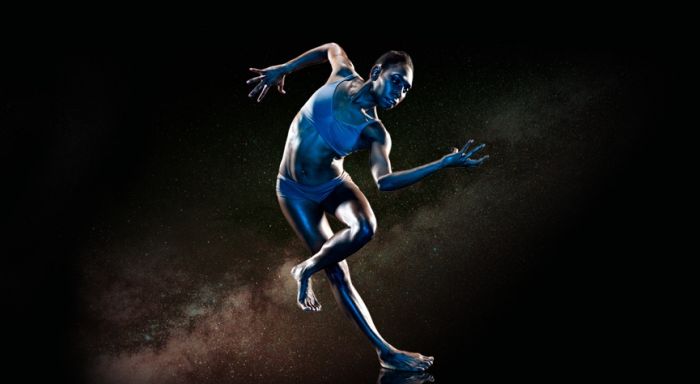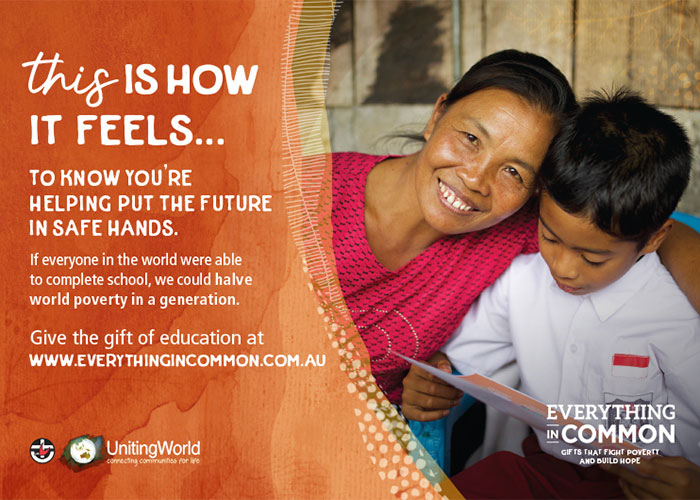The title of Pascoe’s book celebrates Baiame, the creator Spirit Emu which dwells as a dark shape in the Milky Way. While the stars have been the focus of the European gaze, Aboriginal people also see the spaces between – the dark void, so wonderfully visualised by Jacob Nash in the opening and closing sequences. An emblematic image floats in dark space looking down, it seems, on both sky and earth. The silhouetted torsos of the dancers are half revealed or concealed as they glide and retreat along the horizon, arms raised, hands reaching outward and upward in an appeal or reverential ecstasy.
A distinctive feature of Bangarra’s unique style is the almost constant motion of the dancers. They ebb and flow in ensemble, divide and separate into threes, into pairs and break away into solos, but nevertheless give the impression of being a whole, united by understanding of, and connection with an invisible but strongly felt spiritual presence. At the same time their sinuous twining and untwining, folding and unfolding, closing and opening movements and gestures suggest the cyclic nature of existence, its vitality, its decay and its resilience.
A gift of creation, the seeds contained in their protective pod at once sustain life by being consumed and by reproducing their kind. In itself it is a sacred object, a visual representation of the cycle of birth, decay, rebirth that guarantees permanence. In an excited flurry of shredded cream linen (costumes, Jennifer Irwin), the dancers take on the vitality of the kangaroo grass that flourished in most parts of the continent pre-invasion, and as producer of a nutritious grain, sustained both emu and people.
This rich and ancient story of reciprocal relationship between land and people, or economic and spiritual governance, is deepened by the dramatically powerful “Forge by Fire”, a fluttering “Bogong Moth Harvest” and the skillful making of stone fish traps in “Rocks of Knowledge”. Through a perfect melding of movement, setting, costume, soundscape (composer, Steve Francis), lighting (Sian James-Holland) and spoken word, we are given startling glimpses into ancestral “hubs of knowledge” that underpin a deliberate management of country and reciprocal relationship with its animals.
We know with sharp discomfort the next episodes in this story. In the elegiac “Bowls of Mourning”, the heavy, downward movements of the women show how deeply they have been crushed by European blindness to Aboriginal culture. At the same time, the women’s caps of moulded gypsum, the wooden platform on which they sit, and their ritual funereal practices are undeniable evidence of a sophisticated people. We see with shame the bewildered dancers herded like the cattle brought by the European invaders to heedlessly trample down the age-old ground cover and compact the friable soil. The detested sound of the blowfly, an invasion of another kind, conveys both physical disease and mental despair.
Yet the wonderful Bangarra Dance Theatre itself has been the means of reconnecting Aboriginal and Torres Strait Islander young with the land, awakening the white Australian consciousness to the incomparable value of the world’s oldest culture and being itself a seminal force in that culture’s rebirth. Who else could show us with such grace the folly of an economy that operates independently of morality? And who could not be touched and humbled by the concluding words (Alana Valentine, dramaturg), “I am the spirit of country, still giving life to the land – thank you, my country”.
The absolute highlights of Dark Emu in a performance of uniformly superb dance technique, were “Grain Dust” (a mesmerising Kaine Sultan-Babji, Beau Dean Riley Smith and Yolanda Lowatta), “Rebirth Ritual” (again, a mesmerising Yolanda Lowatta), break-away solos by Waangenga Blanco and Beau Dean Riley Smith, and, as always, the surety of intention brought to her movements by Elma Kris.
Thank you team Bangarra, both creatives and ensemble of brilliant dancers, for your generous sharing of cultural knowledge and your commitment to deeply worked performance.





